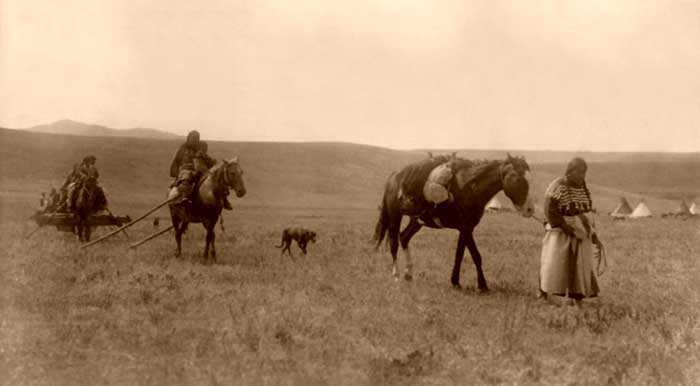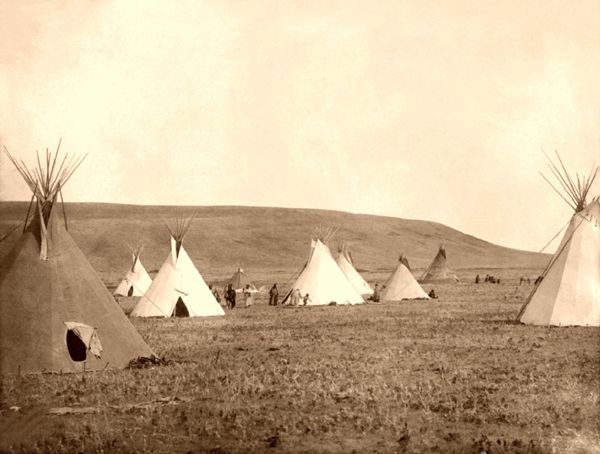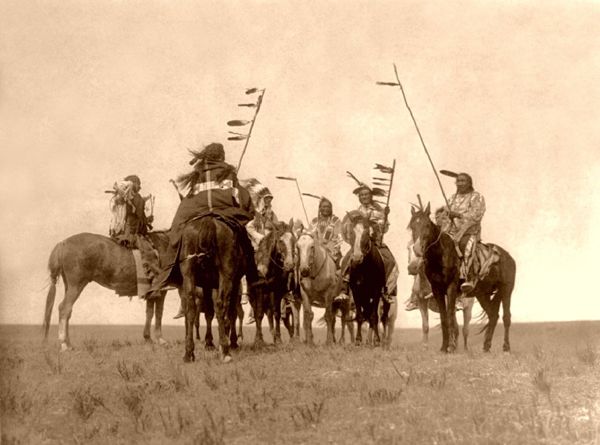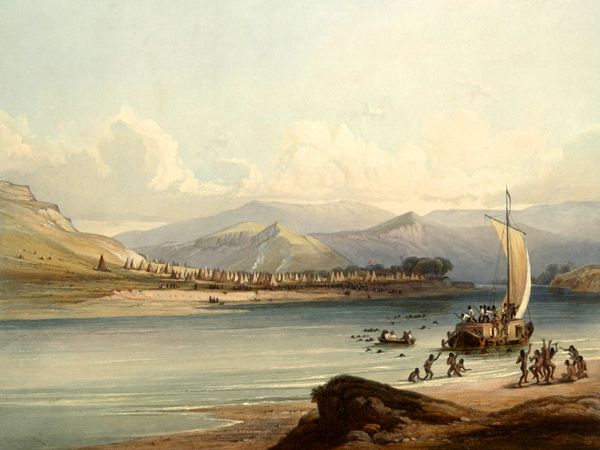Pronounced “Grow Vaunt,” the word means “big belly” in French. No one knows exactly why the French called them this. They were also known as the Ahe, A’aninin, Ahahnelin, A’ane, Haaninin, and Atsina.
The Gros Ventre and the Arapaho were once part of the same large tribe who lived in the western Great Lakes region 3000 years ago, where they lived an agricultural lifestyle, cultivating maize.
They were an Algonquian-speaking people who lived along the Red River valley in northern present-day Minnesota and Manitoba, Canada. They called themselves A’aninin, the White Clay People, and were closely associated with the ancestors of the Cheyenne.
In the early 18th century, the large tribe split, forming the Gros Ventre and the Arapaho. These, with the Cheyenne, migrated into Montana under pressure from the Ojibwe. After they migrated, the Arapaho moved southwards to the Wyoming and Colorado area, while the Cheyenne migrated south into South Dakota and Colorado.
They spoke the now nearly extinct Gros Ventre language (Atsina). The tribe acquired horses in the mid-18th century and then began to migrate farther south to the Great Plains of Wyoming and Colorado to hunt buffalo.
Aboriginally, the Gros Ventre were divided into 12 bands, each of which was led by a chief who usually made decisions in consultation with other male members of the band. Chiefs were awarded their status because of their prowess in war. In winter, the bands usually camped separately but came together in the spring and fall for large buffalo hunts and various ceremonies. They subsided primarily on buffalo but also hunted deer, elk, and antelope, and the women collected berries, fruits, and roots.
All young girls were given in marriage before puberty to older men, but the marriage was usually delayed until the girls were about 20 years old. Polygamy was common, as was divorce, which the husband usually initiated. Most women married three or four times during their lifetime. Children belonged to the band of their father.
At adolescence, boys entered one of the age-graded societies. Also, they became members of either the Star Society or the Wolf Society, each with peacekeeping and social functions. At death, the individual had a scaffold burial in a tree or cave with some personal possessions. The Flat Pipe and Feathered Pipe Rites were important Ceremonies, with personal supernatural powers and visions also significant.
The earliest known contact of Gros Ventre with white men was in about 1754, between the north and south forks of the Saskatchewan River. At that time, they were exposed to smallpox, severely reducing their numbers. Around 1793, in response to attacks by well-armed Cree and Assiniboine, large groups of Gros Ventre burned two Hudson’s Bay Company trading posts providing guns to the Cree and Assiniboine tribes in what is now Saskatchewan (Canada).
Lewis and Clark reported the Gros Ventre were living in two groups when they came through. They called the northern group, who were living on the Upper Saskatchewan River in Canada, the Fall Indians. They said they numbered about 2,500 people living in 260 tipis who traded with the North West Company. They called the southern group the Staetan tribe and described them as roaming between the Missouri and Bow Rivers, a population of about 400 people living in 40 tipis, and having close contact with bands of Northern Arapaho.
In 1832, the Gros Ventre made contact with the German explorer and naturalist Prince Maximilian. Along with the naturalist painter Karl Bodmer, the Europeans painted portraits and recorded their meeting with the Gros Ventre near the Missouri River in Montana.
Somewhere along the line, the Gros Ventre joined the Blackfeet Confederacy. After allying with the Blackfeet, the Gros Ventre moved to north-central Montana and southern Canada. In 1855, Washington Territorial Governor Isaac Stevens negotiated a treaty to provide peace between the United States and the Blackfeet, Flathead, and Nez Perce tribes. The Gros Ventre signed the treaty as part of the Blackfeet Confederacy, whose territory near the Three Fork area became a common hunting ground for the tribes. In 1861, the Gros Ventres left the Blackfeet Confederacy.
Allying with the Crow, the Gros Ventre fought the Blackfeet, but in 1867, they were defeated.
In 1868, the United States government established a trading post called Fort Browning near the mouth of Peoples Creek on the Milk River. This trading post was built for the Gros Ventre and Assiniboine, but because it was on a favorite hunting ground of the Sioux, it was abandoned in 1871. The government then built Fort Belknap, which served as a trading post and an issue building, where the tribe received their rations and annuity goods. It was located about one mile southwest of the present town of Harlem, Montana.
In 1876, the fort was discontinued, and the Gros Ventre and Assiniboine people who were receiving annuities at the post were instructed to go to the agency at Fort Peck and Wolf Point. The Assiniboine did not object to going to Wolf Point and readily went about moving, but the Gros Ventre refused to go. If they did, they would come into contact with the Sioux, with whom they didn’t get along. They forfeited their annuities rather than move to Fort Peck. In 1878, the Fort Belknap Agency was re-established, and the Gros Ventre and remaining Assiniboine were again allowed to receive supplies at Fort Belknap (there is also an unrelated Fort Belknap in Texas).
In 1884, gold was discovered in the Little Rocky Mountains. Pressure from miners and mining companies forced the tribes to cede sections of the mountains in 1885. Jesuits came to Fort Belknap in 1862 to convert the Gros Ventre people to Catholicism. In 1887, St. Paul’s Mission was established at the foot of the Little Rocky Mountains near Hays. Afterward, many of the traditional ceremonies were lost over the course of time. However, the two sacred pipes, The Feathered Pipe and The Flat Pipe, remain central to the traditional spiritual beliefs of the Gros Ventre.
By an act of Congress, the Fort Belknap Indian Reservation was established on May 1, 1888, for the Gros Ventre and Assiniboine tribes, resulting in the Indians ceding 17,500,000 acres of their joint reservation lands.
Today the Gros Ventre are a federally recognized tribe with 4,000 enrolled members, including the Assiniboine, who were once the historical enemies of the Gros Ventre tribe. The Fort Belknap Reservation and additional tribal lands encompass 650,000 acres of the plains and grasslands of northcentral Montana. Its headquarters is located just south of the small town of Harlem, Montana.
More Information:
Fort Belknap Indian Community
656 Agency Main Street
Harlem, MT 59526
406-353-2205
Compiled by Kathy Alexander/Legends of America, updated January 2023.
Also See:
Native Americans – The First Owners of America
Native American Heroes & Leaders
Sources:




